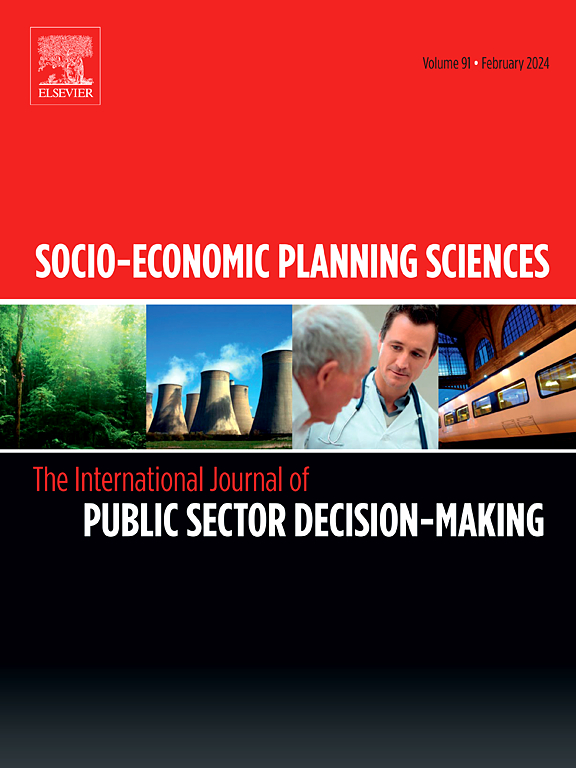Cluster-based healthcare network design problem with referral system using a hybrid genetic algorithm
IF 6.2
2区 经济学
Q1 ECONOMICS
引用次数: 0
Abstract
Addressing the unbalanced distribution of demands and medical resources is a particularly important issue in many healthcare systems. To achieve the equitable and efficient utilization of medical resources across regions, various medical alliances with tiered hospitals have been proposed and promoted to implement patient referrals. However, no formal analysis has been conducted on the implementation and management of medical alliances, especially over large geographical areas. This paper proposes the cluster-based healthcare network design problem with a referral system that provides a framework for integrating healthcare districting and patient referral problems within a hierarchical healthcare network design. It partitions the healthcare network into several clusters based on administrative features and designs diverse referral strategies for heterogeneous patients. To address the proposed problem, a mixed-integer linear programming model is formulated, and a hybrid genetic algorithm framework is developed to solve it efficiently. This algorithm considers the cluster-based nature of the healthcare networks and incorporates local search strategies to guarantee convergence performance. To demonstrate the efficiency of the proposed method, a case study is conducted involving 93 hospitals in Hebei, China. The results reveal that the proposed model can be extensively used to help decision-makers make informed decisions about constructing effective healthcare networks containing multiple medical alliances to reduce costs and improve efficiency. Furthermore, it suggests that a healthcare system equipped with a multi-hub configuration, diverse referral strategies, and a more relaxed capacity setting exhibits excellent performance in terms of costs and resilience. Finally, our study demonstrates that the proposed algorithm performs well in terms of efficiency and robustness.
使用混合遗传算法解决带有转诊系统的基于集群的医疗保健网络设计问题
在许多医疗保健系统中,解决需求和医疗资源分配的不平衡是一个特别重要的问题。为实现区域间医疗资源的公平高效利用,提出并推动了分级医院的各种医疗联盟,实现患者转诊。但是,没有对医疗联盟的实施和管理进行正式分析,特别是在大的地理区域。本文提出了一个基于集群的医疗网络设计问题,该问题提供了一个框架,用于在分层医疗网络设计中集成医疗分区和患者转诊问题。它根据管理特征将医疗网络划分为几个集群,并为异质患者设计不同的转诊策略。针对该问题,建立了混合整数线性规划模型,并开发了混合遗传算法框架进行求解。该算法考虑了医疗网络基于集群的特性,并结合了本地搜索策略以保证收敛性能。为验证该方法的有效性,以河北省93家医院为例进行了实证研究。结果表明,该模型可广泛用于帮助决策者在构建包含多个医疗联盟的有效医疗网络时做出明智决策,以降低成本和提高效率。此外,这表明配备多中心配置、多样化转诊策略和更宽松的容量设置的医疗保健系统在成本和弹性方面表现出色。最后,我们的研究表明,该算法在效率和鲁棒性方面表现良好。
本文章由计算机程序翻译,如有差异,请以英文原文为准。
求助全文
约1分钟内获得全文
求助全文
来源期刊

Socio-economic Planning Sciences
OPERATIONS RESEARCH & MANAGEMENT SCIENCE-
CiteScore
9.40
自引率
13.10%
发文量
294
审稿时长
58 days
期刊介绍:
Studies directed toward the more effective utilization of existing resources, e.g. mathematical programming models of health care delivery systems with relevance to more effective program design; systems analysis of fire outbreaks and its relevance to the location of fire stations; statistical analysis of the efficiency of a developing country economy or industry.
Studies relating to the interaction of various segments of society and technology, e.g. the effects of government health policies on the utilization and design of hospital facilities; the relationship between housing density and the demands on public transportation or other service facilities: patterns and implications of urban development and air or water pollution.
Studies devoted to the anticipations of and response to future needs for social, health and other human services, e.g. the relationship between industrial growth and the development of educational resources in affected areas; investigation of future demands for material and child health resources in a developing country; design of effective recycling in an urban setting.
 求助内容:
求助内容: 应助结果提醒方式:
应助结果提醒方式:


